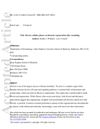Search
forLearn
5 / 9 resultslearn Osteopontin
signaling protein that, when suppressed, may grow hair by reducing inflammation and stem cell loss
learn Tretinoin
the gold standard retinoid in dermatology that's also helpful for hair regrowth alongside Minoxidil
learn Valproic acid
an anticonvulsant repurposed for hair loss via histone inhibition
learn Epidermal Growth Factor
Research
5 / 1000+ results
research First Symposium on Natural Gene Therapy of the Skin
Natural gene therapy shows promise for treating skin disorders like epidermolysis bullosa.

research CRISPR/Cas9-Based Targeted Genome Editing for Correction of Recessive Dystrophic Epidermolysis Bullosa Using iPS Cells
The research showed that CRISPR/Cas9 can fix mutations causing a skin disease in stem cells, which then improved skin grafts in mice, but more work on safety and efficiency is needed.
research In Vivo Alteration of the Keratin 17 Gene in Hair Follicles by Oligonucleotide-Directed Gene Targeting
Injecting specific oligonucleotides can change hair growth and structure by altering a gene.

research Advances in Genetic and Molecular Understanding of Omenn Syndrome: Implications for the Future
Newborn screening and gene therapy are expected to improve outcomes for Omenn syndrome patients.

research Diverse Cellular Players Orchestrate Regeneration After Wounding
Different cell types work together to repair skin, and targeting them may improve healing and reduce scarring.
Community Join
5 / 395 resultscommunity UCLA scientists found a molecule — PP405 — that wakes up sleeping hair follicles and tells them, “Do your job.”
PP405 is a promising molecule that may reactivate dormant hair follicles, potentially offering a new treatment for hair loss. It is in phase 2 trials, with possible availability between 2027 and 2030.
community Testosterone and DHT levels through the roof yet has better hair than the majority of guys who are “healthy” genetics are everything
The conclusion of this conversation about hair loss is that genetics play a significant role in determining hair loss, and specific treatments like finasteride may not be effective against certain compounds like masteron and trenbolone.
community DIY treatment... Shedding completely stopped after 1.5 yrs
Vitamin C mixed with shampoo stopped shedding and promoted hair regrowth after 1.5 years. Both the person and their wife experienced significant hair loss reduction with this method.
community Fin/Min/VitD 3 month progress pics
A user shared their positive 3-month experience using finasteride, minoxidil, and vitamin D to treat hair loss, noting significant regrowth and minimal shedding. They also discussed potential side effects and the low likelihood of experiencing them, while being open to answering further questions.
community Why is it that low testosterone causes hair loss as well? How can I be balding?
The conversation discusses the confusion over low testosterone potentially causing hair loss, with users sharing personal experiences and knowledge about hair loss treatments like Finasteride. Some users suggest that hair follicle sensitivity to DHT, not testosterone levels, is the key factor in balding, and others discuss the side effects of hair loss medications.